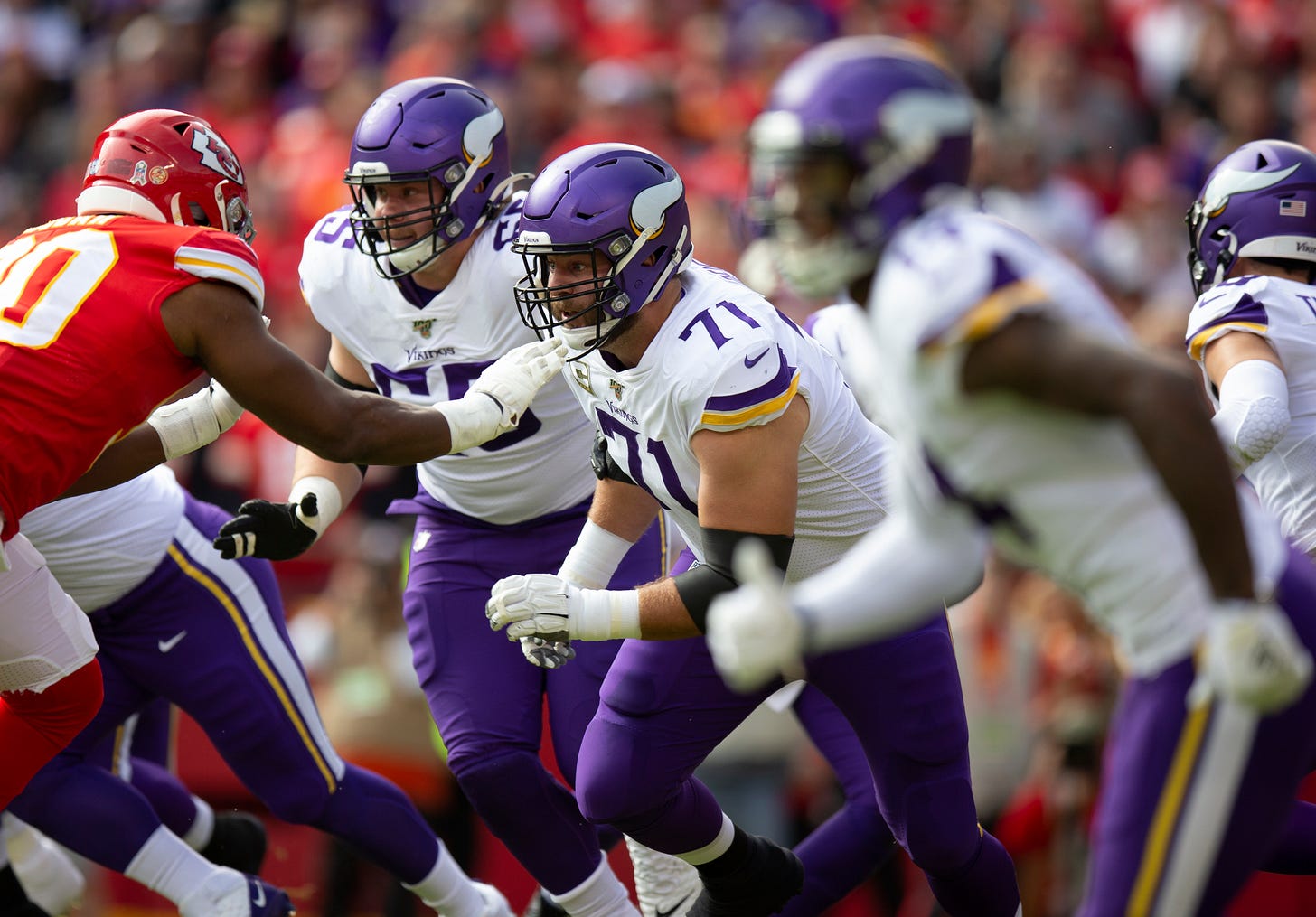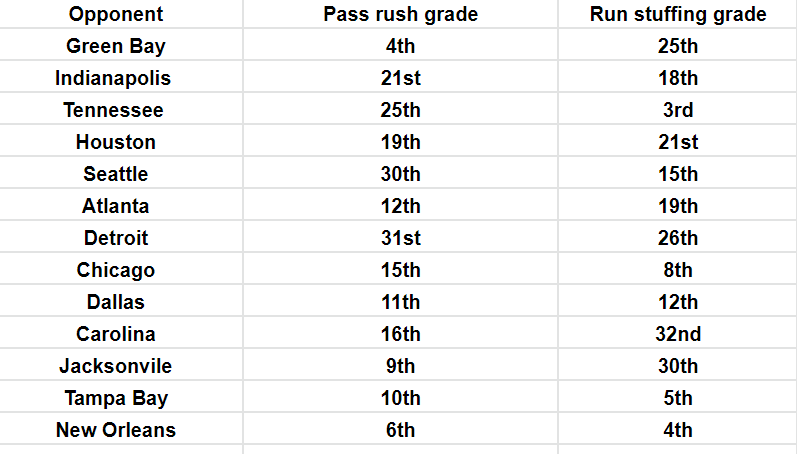With Reiff back, projecting the Vikings' offensive line for 2020
Will they improve from last year?

Sign up for Purple Insider for $5.60 per month or $56 per year to get credentialed access inside the Vikings, from in-depth analysis to behind-the-scenes features to the ever-popular Friday Mailbag. Photo courtesy of the Minnesota Vikings
If it feels like the Minnesota Vikings have struggled to put together an effective offensive line during the Mike Zimmer era, it isn’t your imagination.
Since 2014, the Vikings have ranked 32nd, 31st, 23rd, 12th, 29th and 24th in pass blocking efficiency, according to Pro Football Focus.
In 2019, Kirk Cousins’s quarterback rating when he was kept clean was 118.1 and 84.9 when pressured. His completion percentage dropped from 77.1% in a solid pocket to 52.4% when under duress and yards per attempt sunk from 9.0 to 6.2 when pressured.
Cousins was the 10th most pressured QB in the NFL at 36.4% of drop backs. If the Vikings’ offensive line can reduce that percentage even marginally (and some of it lands on the shoulders of the quarterback), Cousins has a strong chance to repeat his strong 2019 performance or improve on it.
Offensive line coach Rick Dennison was asked on Tuesday whether he thinks the line is better than last season.
“Yes I do, I think a year underneath [their belt],” he said. “Everybody’s trained hard. They know what to expect. And I think obviously we have to go out and perform but I think we’ll take a good step.’’
They are going to need a big step. Here’s how the starting five performed last year by PFF metrics:

Interestingly, Reiff’s return via a re-worked contract gives the Vikings more certainty than they would have had if he’d been cut but there are still questions to be answered at each of the interior positions, starting with whether Garrett Bradbury can improve from a bottom-tier performance by PFF metrics as a rookie.
“He’s probably made the biggest step,” Dennison said of Bradbury. “Not that he was bad last year, he played very well as a rookie. But he really does take command. He’s no longer asking questions, but he’s making suggestions – ‘Do you ever think about this kind of footwork? Do you ever think about doing it this way?’ Which I love. I love the input…. He’s really commanded the whole thing…He gets both sides tied together. He’s become very vocal and taken a hold of the group.”
Bradbury’s progress will be tested right away. Last year in two games against the Green Bay Packers, he gave up 11 total pressures, three of which were sacks. Those two games against Green Bay’s monster defensive tackle Kenny Clark resulted in 42% of the total pressures he allowed all year.
By the numbers, Bradbury doesn’t necessarily have to become Jason Kelce or Alex Mack, he simply has to cut down on disaster-level performances. Last year he graded five times under 40 by PFF pass blocking grades and twice a 0.0 (out of 100). The remainder of his games in pass protection ranged from average to good. Nine times Bradbury allowed either zero or one pressure.
At left guard, Dakota Dozier is difficult to project. Over his career, he’s only played more than 300 snaps in a season once and that was last year. His 18 pressures allowed in just 201 pass blocking snaps was the worst rate in the NFL. But in previous stints during his time as a Jet, he didn’t struggle nearly that much, giving up 11 pressures in 253 snaps from 2015-2018.
“I know he knows what he’s doing,” Dennison said of Dozier. “He understands the technique, the assignments. I think his confidence has risen. I think he feels very comfortable. He’s come in and he always plays hard, but he’s played with a different level of confidence.”
How long the Vikings’ confidence in him will remain high will depend on his play early on against terrific players like Kenny Clark, Za’Darius Smith, DeForest Buckner etc.
The question is whether they might have plans to eventually turn to Ezra Cleveland (who has transitioned to left guard from tackle in college) in the same way Brian O’Neill worked his way into the lineup as a rookie in 2018.
“I think looking at him in college, the way he played the tackle position, which he did a fine job, he likes shorter spaces,” Dennison said. “He’s got great feet, great balance, but he likes smaller spaces. So we thought we’d start there and work into his length.”
That sounds more like a development plan for Cleveland than a plot to have him take over left guard. We could also see Aviante Collins, who Dozier beat out, eventually finding his way into the if he’s retained on cutdown day.
Over the last two seasons, Pat Elflein has fallen from a promising potential franchise center to one of the league’s worst pass blockers in 2018 and 2019. Now at right guard, he’s on his third position in three years.
“I think he’s really done a good job, like everything it’s a little bit of an adjustment with footwork, but he’s done a good job and has worked really well,” Dennison said. “He’s really improved the last couple weeks. The first couple days, he had some issues that we had to work on. One thing about Pat and the rest of the guys, they really take coaching.”
Elflein has farther to go in order to reach average than Bradbury. Nine of his 15 games last year were graded below 50 by PFF in pass blocking.
If Elflein doesn’t return to 2017 form, backup Dru Samia could be next-man up. Many believed that Samia would have a chance at the starting job in his sophomore season but he hasn’t seen any first-team reps throughout camp.
Schedule can be a determining factor for how well a team’s offensive line performs. It stands to reason that the more superstars they face, the more rough outings are likely to happen.
By last year’s metrics, the first half of the season could offer manageable games early on and much tougher tests late in the season.

However, not all of these teams have remained the same since 2019. The Colts, for example, picked up DeForest Buckner in the offseason. In the opening game of the 2018 season he destroyed the Vikings’ offensive line as a member of the 49ers with three sacks.
Later on in the year they will see the likes of Grady Jarrett, Khalil Mack, Everson Griffen, Kawaan Short, Shaq Barrett and Cam Jordan. That’s when we will really find out if the line is improved.
At very least with the return of Reiff, they have a chance to trend closer to average, which would be a victory considering the questions that still remain.
Check out our sponsor SotaStick and their Minnesota-inspired gear by clicking the logo. Use the code PurpleInsider for free shipping


On the plus side, the PFF rankings show that Rieff, despite all the grief he gets, is a slightly above average LT, and O'Neill, of course is better than that. So we're in good shape on the outside. And you have to think Bradbury will be better in year 2, but the coaches confidence in Elflein is bizarre--or maybe it's overconfidence in themselves. Dennison has a well-deserved reputation for all his years of success, but it seems like the Viking think his schemes can turn poor players into good ones...
Kirk is awesome when he isn't pressured, but looks hopeless when he is so I was under the (mistaken) impression when they traded away Diggs and re-upped Kirk that they'd make a much better effort to improve the interior of the O-line and give Kirk some time to make us Like That.
Based on reports on how good Udoh's looked at RT in practices you do wonder what the Vikes would have done with a real off-season. If Udoh at RT, O'Neill at LT, and Reiff at LG could have worked. Maybe, like with Ngakoue, Rick can use one of his two million draft picks next year to swing a trade for a RG that won't get bull rushed onto his kiester five or six times a game. Last thought: It's always fun to use "kiester" in a sentence.
I hope they all spent the off season pumping iron and working on technique. In fact, I wish they would start a continuous "HOF Larry Allen" competition to be the strongest on the line. It was clearly stated in the most excellent Olin Kreutz interview... get stronger!